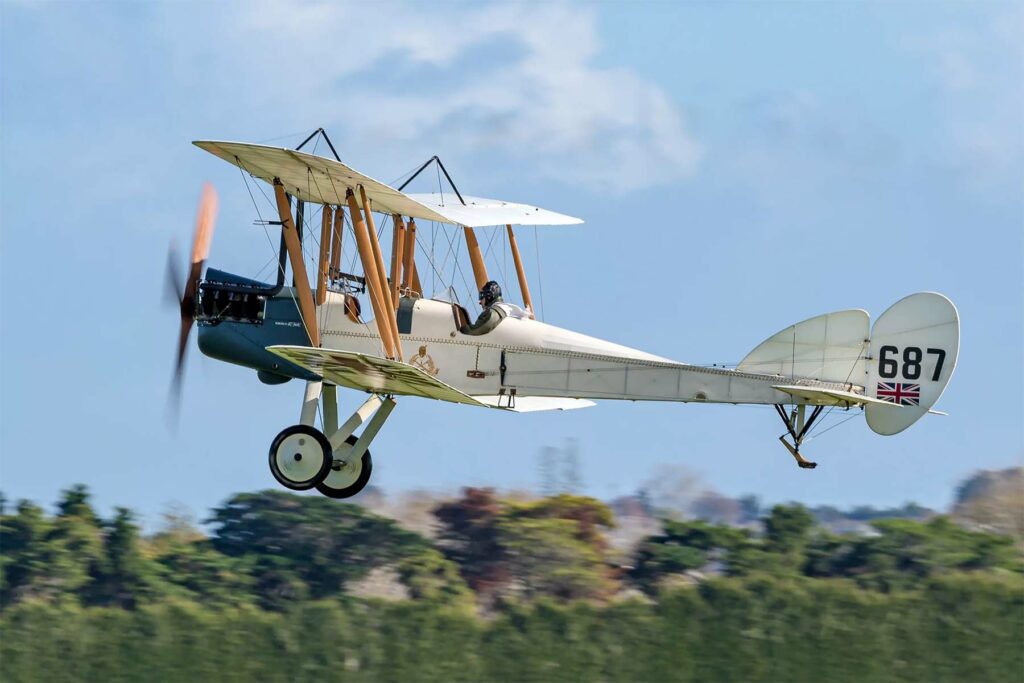Dive into the Royal Aircraft Factory B.E.2’s history, design, and military use—an iconic British aircraft that played a crucial role during World War I.
The Royal Aircraft Factory B.E.2 was a pivotal aircraft in early aviation, particularly during WWI. This piece delves into its inception, design nuances, performance metrics, and military applications, offering an encompassing look at its legacy. The advent of aviation marked a transformative epoch in military strategy, with the Royal Aircraft Factory B.E.2 emerging as a seminal British aircraft during World War I. Its journey, from design board to the battlefront, tells a story of innovation amid global conflict.
History of the development of the Royal Aircraft Factory B.E.2
Set against the backdrop of the early 20th century, Europe was a tinderbox. With the looming threat of large-scale conflict, nations sought technological advantages. Aviation, still in its infancy, was perceived as the next frontier in reconnaissance and combat.
The Royal Aircraft Factory in the UK, sensing the urgency, initiated the B.E.2 program. Launched in the pre-WWI era, the aircraft was primarily conceived for reconnaissance. The “B.E.” in its name stands for “Blériot Experimental”, paying homage to the pioneering French aviator, Louis Blériot.
Taking to the skies for the first time on February 1, 1912, the B.E.2 was a testament to British engineering prowess. As for a NATO nickname, the concept is inapplicable. NATO naming conventions were a post-WWII system, and the B.E.2 predates this.
Design of the Royal Aircraft Factory B.E.2
The B.E.2 was a biplane, characterized by its staggered wings and a distinctive tailplane. With a wingspan of roughly 36 feet 6 inches (11.13 meters) and a length of 27 feet 3 inches (8.31 meters), it wasn’t particularly large but was robust.
One of its notable design choices was the placement of the pilot in the rear cockpit, with the observer in the front—a departure from contemporary norms. This offered the observer an unobstructed forward view, essential for reconnaissance.
Advantages:
- Stability: The B.E.2 was incredibly stable—a boon for reconnaissance missions requiring steady flight.
- Simple Construction: Its design was relatively straightforward, facilitating production and repairs.
Drawbacks:
- Defensive Vulnerability: Its inherent stability made it predictable, a disadvantage during aerial combat.
- Limited Armament Options: Initial designs lacked forward-firing guns, relying on the observer for defense.

Performance of the Royal Aircraft Factory B.E.2
Powered by various engines through its iterations, the most common was the RAF 1a air-cooled V-8 engine, producing about 90 hp. The B.E.2c variant could reach a top speed of 72 mph (115 km/h) and had a service ceiling of around 10,000 feet (3,048 meters). With a range of 350 miles (563 kilometers), it was adequately equipped for extended reconnaissance missions.
Compared to some contemporaneous aircraft, the B.E.2 wasn’t the fastest, but its stability and endurance often gave it an edge in reconnaissance roles. However, this also made it vulnerable to more agile enemy fighters.
Military use and combat of the Royal Aircraft Factory B.E.2
During WWI, the B.E.2 was extensively deployed by the Royal Flying Corps (RFC). Initially used for reconnaissance, its roles expanded to include light bombing and even intercepting enemy airships.
Armament was modest. Early versions primarily relied on the observer’s movable .303 Lewis Gun. Later models incorporated more armaments, including small bomb loads.
However, the B.E.2 faced challenges. German fighters, especially the Fokker Eindecker, exploited the B.E.2’s vulnerabilities. By 1917, with advancements in aviation, the B.E.2 was increasingly outclassed and began phasing out from frontline service.
While primarily a British warbird, some were used by other countries, including Australia and Russia. Post-WWI, it gradually faded from military use, replaced by newer, more advanced aircraft.
The Royal Aircraft Factory B.E.2 encapsulates the audacious spirit of early aviation. While it had its limitations, its contributions to reconnaissance and light bombing during WWI are undeniable. As with many pioneers, it faced challenges, but its legacy in the annals of aviation history is firmly cemented.
Back to the Warbirds section.